Digital Communication Challenges Faced by International Firms: MGT502
VerifiedAdded on 2022/09/26
|11
|2411
|17
Homework Assignment
AI Summary
This annotated bibliography explores the multifaceted challenges of digital communication within international firms, drawing on a diverse range of academic sources. The student analyzes the difficulties faced by virtual teams, including linguistic and digital incompetence, and the impact of technology on internal communication strategies. The bibliography examines issues such as language barriers, cultural shock, and the importance of trust-building in multicultural organizations. The sources highlight the significance of effective communication for organizational success, emphasizing the need for managers to navigate the complexities of digital communication in a globalized business environment. The annotated bibliography provides insights into marketing approaches, the impact of digitization on consumer relationships, and the importance of strategic communication in achieving desired results, offering a comprehensive overview of the challenges and potential solutions related to digital communication in international business.

Student Name
INSTITUTIONAL AFFILIATION(S)
PART A-ANNOTATED
BIBLIOGRAPHY
INSTITUTIONAL AFFILIATION(S)
PART A-ANNOTATED
BIBLIOGRAPHY
Paraphrase This Document
Need a fresh take? Get an instant paraphrase of this document with our AI Paraphraser
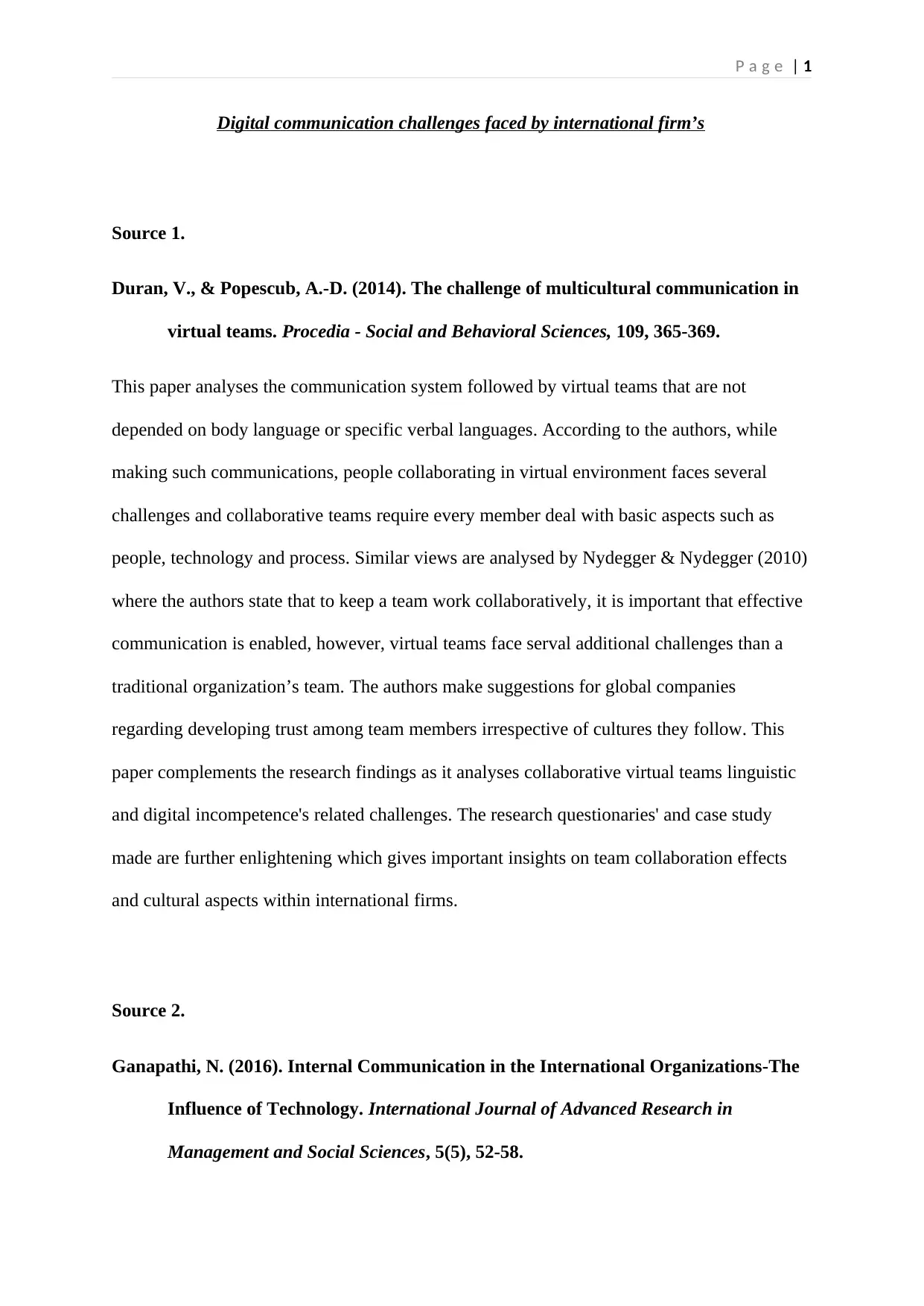
P a g e | 1
Digital communication challenges faced by international firm’s
Source 1.
Duran, V., & Popescub, A.-D. (2014). The challenge of multicultural communication in
virtual teams. Procedia - Social and Behavioral Sciences, 109, 365-369.
This paper analyses the communication system followed by virtual teams that are not
depended on body language or specific verbal languages. According to the authors, while
making such communications, people collaborating in virtual environment faces several
challenges and collaborative teams require every member deal with basic aspects such as
people, technology and process. Similar views are analysed by Nydegger & Nydegger (2010)
where the authors state that to keep a team work collaboratively, it is important that effective
communication is enabled, however, virtual teams face serval additional challenges than a
traditional organization’s team. The authors make suggestions for global companies
regarding developing trust among team members irrespective of cultures they follow. This
paper complements the research findings as it analyses collaborative virtual teams linguistic
and digital incompetence's related challenges. The research questionaries' and case study
made are further enlightening which gives important insights on team collaboration effects
and cultural aspects within international firms.
Source 2.
Ganapathi, N. (2016). Internal Communication in the International Organizations-The
Influence of Technology. International Journal of Advanced Research in
Management and Social Sciences, 5(5), 52-58.
Digital communication challenges faced by international firm’s
Source 1.
Duran, V., & Popescub, A.-D. (2014). The challenge of multicultural communication in
virtual teams. Procedia - Social and Behavioral Sciences, 109, 365-369.
This paper analyses the communication system followed by virtual teams that are not
depended on body language or specific verbal languages. According to the authors, while
making such communications, people collaborating in virtual environment faces several
challenges and collaborative teams require every member deal with basic aspects such as
people, technology and process. Similar views are analysed by Nydegger & Nydegger (2010)
where the authors state that to keep a team work collaboratively, it is important that effective
communication is enabled, however, virtual teams face serval additional challenges than a
traditional organization’s team. The authors make suggestions for global companies
regarding developing trust among team members irrespective of cultures they follow. This
paper complements the research findings as it analyses collaborative virtual teams linguistic
and digital incompetence's related challenges. The research questionaries' and case study
made are further enlightening which gives important insights on team collaboration effects
and cultural aspects within international firms.
Source 2.
Ganapathi, N. (2016). Internal Communication in the International Organizations-The
Influence of Technology. International Journal of Advanced Research in
Management and Social Sciences, 5(5), 52-58.
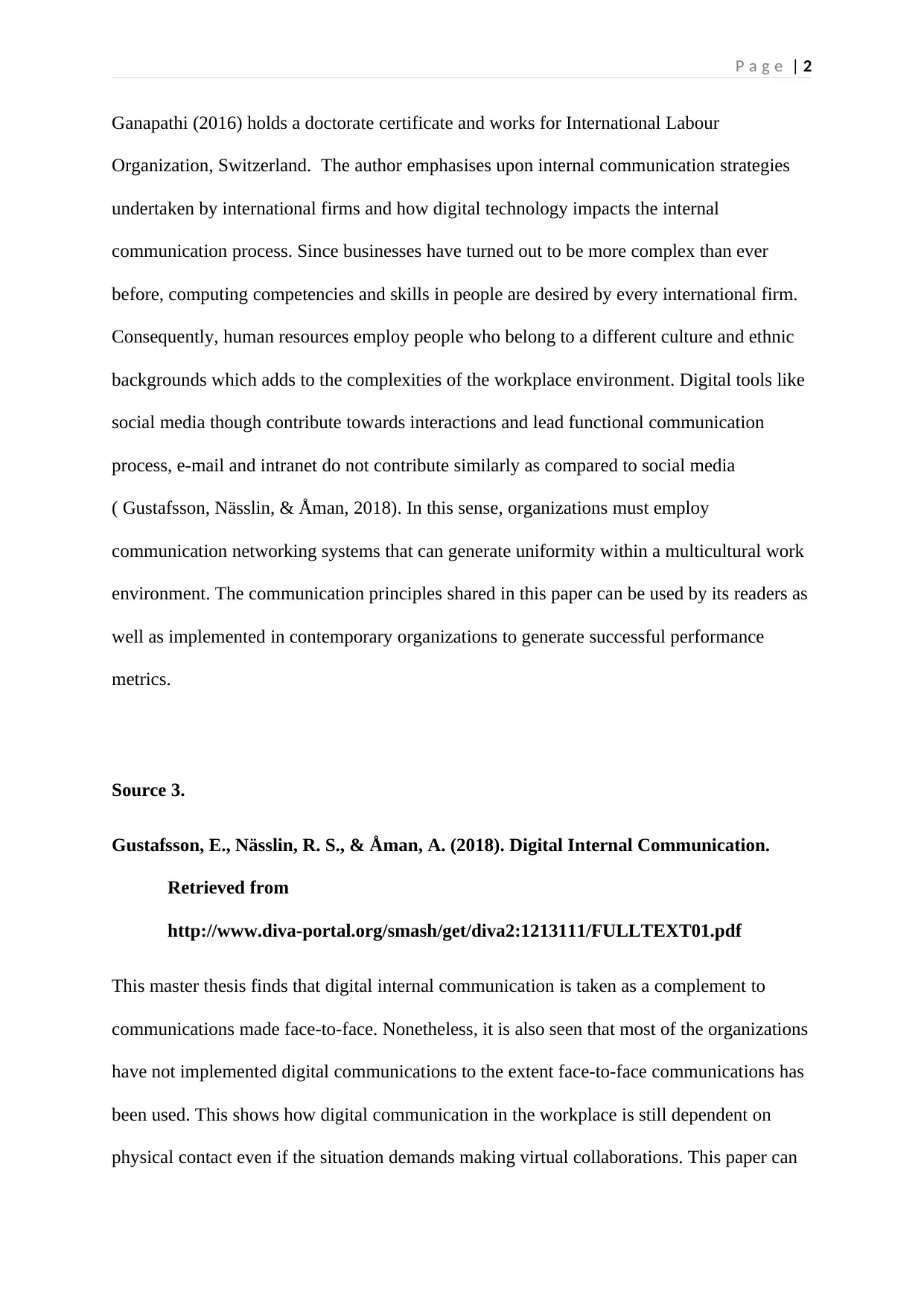
P a g e | 2
Ganapathi (2016) holds a doctorate certificate and works for International Labour
Organization, Switzerland. The author emphasises upon internal communication strategies
undertaken by international firms and how digital technology impacts the internal
communication process. Since businesses have turned out to be more complex than ever
before, computing competencies and skills in people are desired by every international firm.
Consequently, human resources employ people who belong to a different culture and ethnic
backgrounds which adds to the complexities of the workplace environment. Digital tools like
social media though contribute towards interactions and lead functional communication
process, e-mail and intranet do not contribute similarly as compared to social media
( Gustafsson, Nässlin, & Åman, 2018). In this sense, organizations must employ
communication networking systems that can generate uniformity within a multicultural work
environment. The communication principles shared in this paper can be used by its readers as
well as implemented in contemporary organizations to generate successful performance
metrics.
Source 3.
Gustafsson, E., Nässlin, R. S., & Åman, A. (2018). Digital Internal Communication.
Retrieved from
http://www.diva-portal.org/smash/get/diva2:1213111/FULLTEXT01.pdf
This master thesis finds that digital internal communication is taken as a complement to
communications made face-to-face. Nonetheless, it is also seen that most of the organizations
have not implemented digital communications to the extent face-to-face communications has
been used. This shows how digital communication in the workplace is still dependent on
physical contact even if the situation demands making virtual collaborations. This paper can
Ganapathi (2016) holds a doctorate certificate and works for International Labour
Organization, Switzerland. The author emphasises upon internal communication strategies
undertaken by international firms and how digital technology impacts the internal
communication process. Since businesses have turned out to be more complex than ever
before, computing competencies and skills in people are desired by every international firm.
Consequently, human resources employ people who belong to a different culture and ethnic
backgrounds which adds to the complexities of the workplace environment. Digital tools like
social media though contribute towards interactions and lead functional communication
process, e-mail and intranet do not contribute similarly as compared to social media
( Gustafsson, Nässlin, & Åman, 2018). In this sense, organizations must employ
communication networking systems that can generate uniformity within a multicultural work
environment. The communication principles shared in this paper can be used by its readers as
well as implemented in contemporary organizations to generate successful performance
metrics.
Source 3.
Gustafsson, E., Nässlin, R. S., & Åman, A. (2018). Digital Internal Communication.
Retrieved from
http://www.diva-portal.org/smash/get/diva2:1213111/FULLTEXT01.pdf
This master thesis finds that digital internal communication is taken as a complement to
communications made face-to-face. Nonetheless, it is also seen that most of the organizations
have not implemented digital communications to the extent face-to-face communications has
been used. This shows how digital communication in the workplace is still dependent on
physical contact even if the situation demands making virtual collaborations. This paper can
⊘ This is a preview!⊘
Do you want full access?
Subscribe today to unlock all pages.

Trusted by 1+ million students worldwide
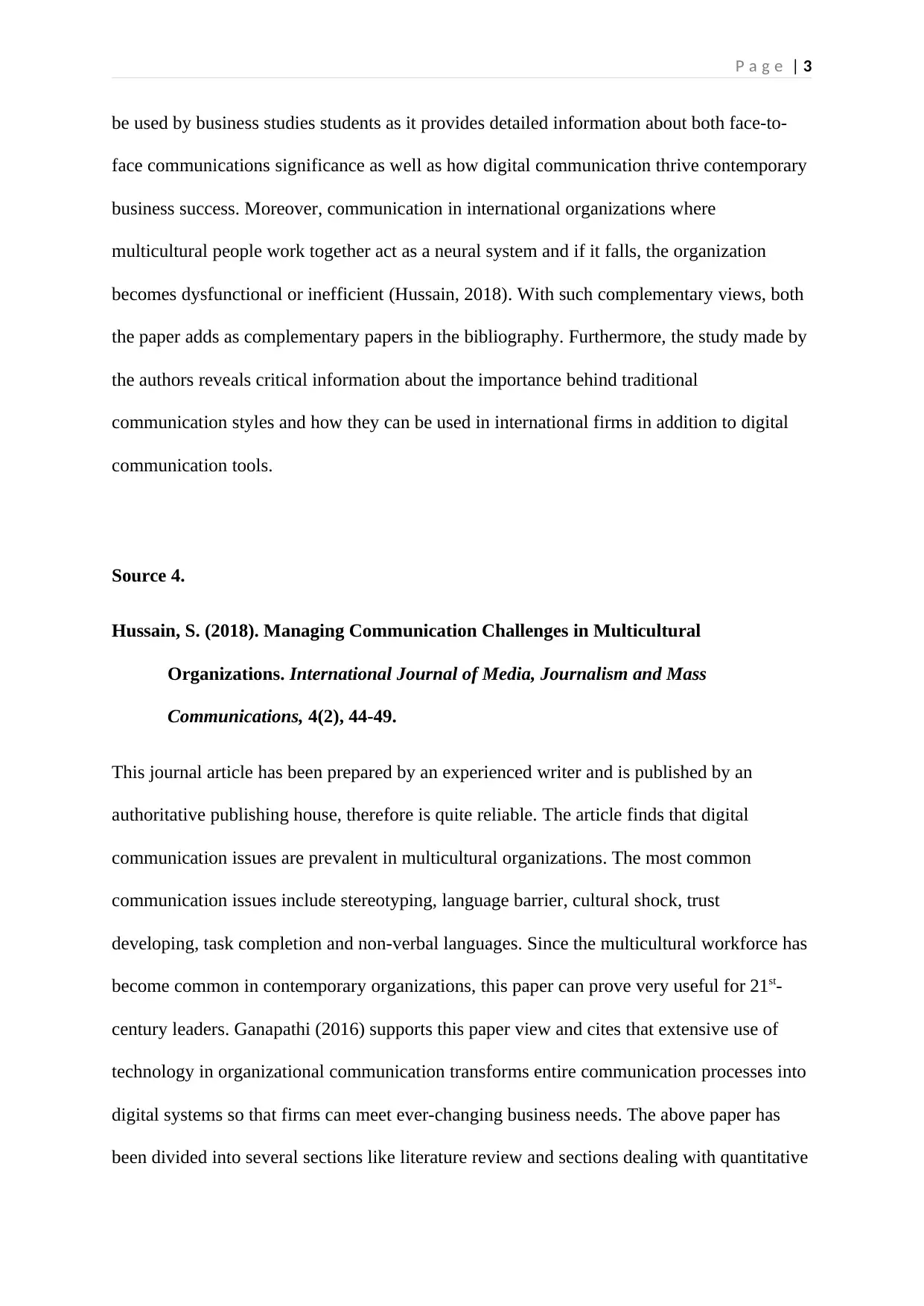
P a g e | 3
be used by business studies students as it provides detailed information about both face-to-
face communications significance as well as how digital communication thrive contemporary
business success. Moreover, communication in international organizations where
multicultural people work together act as a neural system and if it falls, the organization
becomes dysfunctional or inefficient (Hussain, 2018). With such complementary views, both
the paper adds as complementary papers in the bibliography. Furthermore, the study made by
the authors reveals critical information about the importance behind traditional
communication styles and how they can be used in international firms in addition to digital
communication tools.
Source 4.
Hussain, S. (2018). Managing Communication Challenges in Multicultural
Organizations. International Journal of Media, Journalism and Mass
Communications, 4(2), 44-49.
This journal article has been prepared by an experienced writer and is published by an
authoritative publishing house, therefore is quite reliable. The article finds that digital
communication issues are prevalent in multicultural organizations. The most common
communication issues include stereotyping, language barrier, cultural shock, trust
developing, task completion and non-verbal languages. Since the multicultural workforce has
become common in contemporary organizations, this paper can prove very useful for 21st-
century leaders. Ganapathi (2016) supports this paper view and cites that extensive use of
technology in organizational communication transforms entire communication processes into
digital systems so that firms can meet ever-changing business needs. The above paper has
been divided into several sections like literature review and sections dealing with quantitative
be used by business studies students as it provides detailed information about both face-to-
face communications significance as well as how digital communication thrive contemporary
business success. Moreover, communication in international organizations where
multicultural people work together act as a neural system and if it falls, the organization
becomes dysfunctional or inefficient (Hussain, 2018). With such complementary views, both
the paper adds as complementary papers in the bibliography. Furthermore, the study made by
the authors reveals critical information about the importance behind traditional
communication styles and how they can be used in international firms in addition to digital
communication tools.
Source 4.
Hussain, S. (2018). Managing Communication Challenges in Multicultural
Organizations. International Journal of Media, Journalism and Mass
Communications, 4(2), 44-49.
This journal article has been prepared by an experienced writer and is published by an
authoritative publishing house, therefore is quite reliable. The article finds that digital
communication issues are prevalent in multicultural organizations. The most common
communication issues include stereotyping, language barrier, cultural shock, trust
developing, task completion and non-verbal languages. Since the multicultural workforce has
become common in contemporary organizations, this paper can prove very useful for 21st-
century leaders. Ganapathi (2016) supports this paper view and cites that extensive use of
technology in organizational communication transforms entire communication processes into
digital systems so that firms can meet ever-changing business needs. The above paper has
been divided into several sections like literature review and sections dealing with quantitative
Paraphrase This Document
Need a fresh take? Get an instant paraphrase of this document with our AI Paraphraser
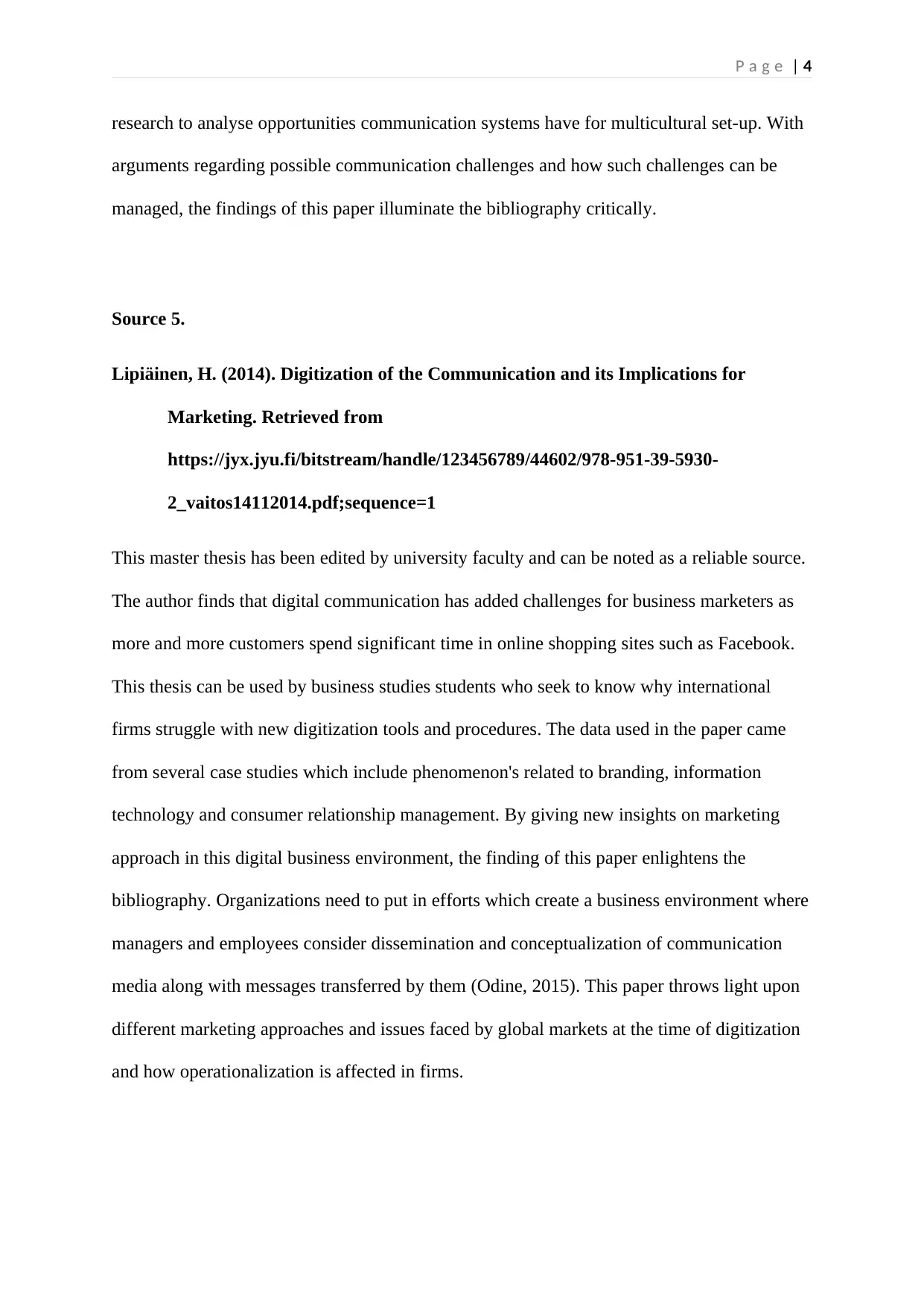
P a g e | 4
research to analyse opportunities communication systems have for multicultural set-up. With
arguments regarding possible communication challenges and how such challenges can be
managed, the findings of this paper illuminate the bibliography critically.
Source 5.
Lipiäinen, H. (2014). Digitization of the Communication and its Implications for
Marketing. Retrieved from
https://jyx.jyu.fi/bitstream/handle/123456789/44602/978-951-39-5930-
2_vaitos14112014.pdf;sequence=1
This master thesis has been edited by university faculty and can be noted as a reliable source.
The author finds that digital communication has added challenges for business marketers as
more and more customers spend significant time in online shopping sites such as Facebook.
This thesis can be used by business studies students who seek to know why international
firms struggle with new digitization tools and procedures. The data used in the paper came
from several case studies which include phenomenon's related to branding, information
technology and consumer relationship management. By giving new insights on marketing
approach in this digital business environment, the finding of this paper enlightens the
bibliography. Organizations need to put in efforts which create a business environment where
managers and employees consider dissemination and conceptualization of communication
media along with messages transferred by them (Odine, 2015). This paper throws light upon
different marketing approaches and issues faced by global markets at the time of digitization
and how operationalization is affected in firms.
research to analyse opportunities communication systems have for multicultural set-up. With
arguments regarding possible communication challenges and how such challenges can be
managed, the findings of this paper illuminate the bibliography critically.
Source 5.
Lipiäinen, H. (2014). Digitization of the Communication and its Implications for
Marketing. Retrieved from
https://jyx.jyu.fi/bitstream/handle/123456789/44602/978-951-39-5930-
2_vaitos14112014.pdf;sequence=1
This master thesis has been edited by university faculty and can be noted as a reliable source.
The author finds that digital communication has added challenges for business marketers as
more and more customers spend significant time in online shopping sites such as Facebook.
This thesis can be used by business studies students who seek to know why international
firms struggle with new digitization tools and procedures. The data used in the paper came
from several case studies which include phenomenon's related to branding, information
technology and consumer relationship management. By giving new insights on marketing
approach in this digital business environment, the finding of this paper enlightens the
bibliography. Organizations need to put in efforts which create a business environment where
managers and employees consider dissemination and conceptualization of communication
media along with messages transferred by them (Odine, 2015). This paper throws light upon
different marketing approaches and issues faced by global markets at the time of digitization
and how operationalization is affected in firms.
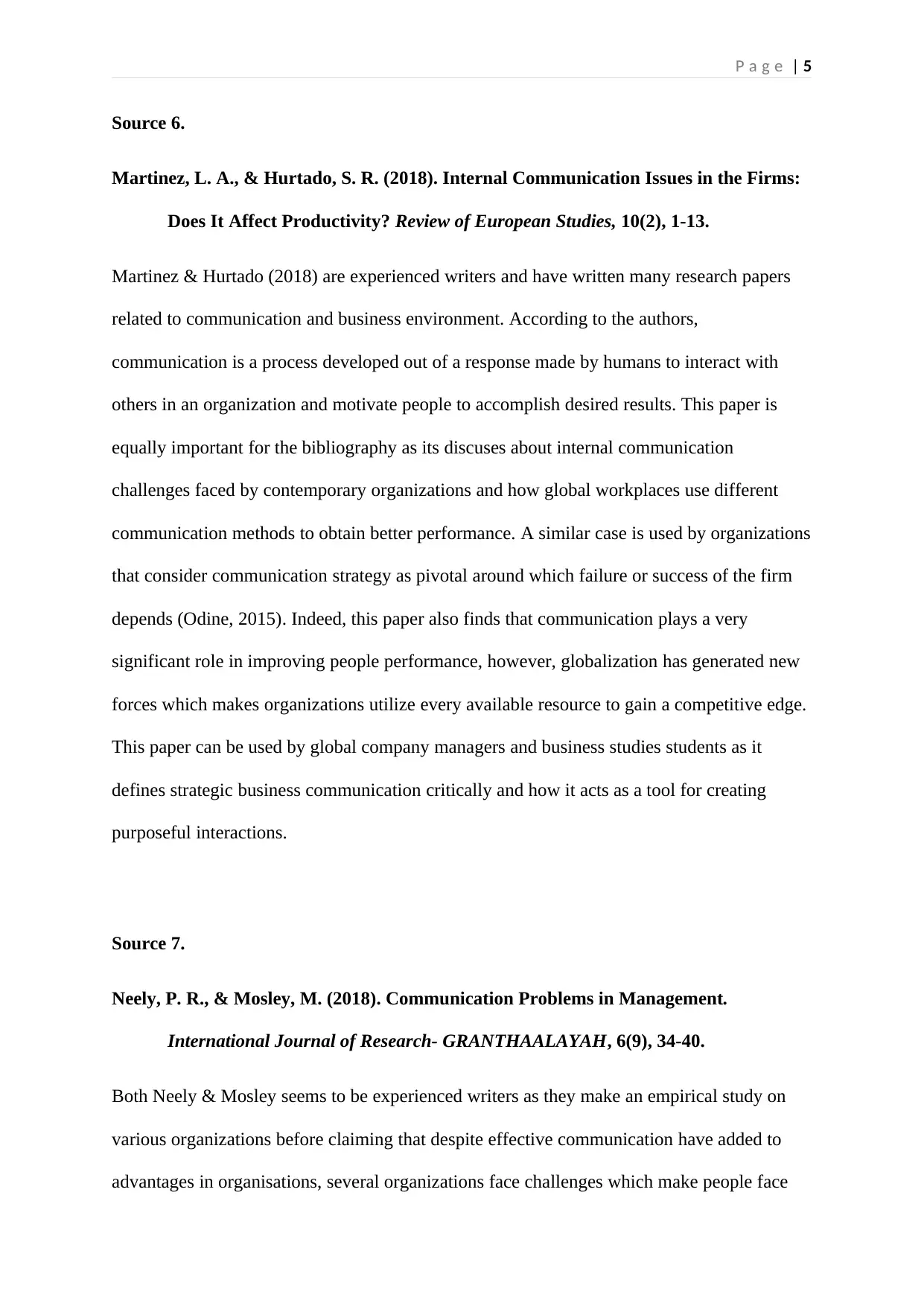
P a g e | 5
Source 6.
Martinez, L. A., & Hurtado, S. R. (2018). Internal Communication Issues in the Firms:
Does It Affect Productivity? Review of European Studies, 10(2), 1-13.
Martinez & Hurtado (2018) are experienced writers and have written many research papers
related to communication and business environment. According to the authors,
communication is a process developed out of a response made by humans to interact with
others in an organization and motivate people to accomplish desired results. This paper is
equally important for the bibliography as its discuses about internal communication
challenges faced by contemporary organizations and how global workplaces use different
communication methods to obtain better performance. A similar case is used by organizations
that consider communication strategy as pivotal around which failure or success of the firm
depends (Odine, 2015). Indeed, this paper also finds that communication plays a very
significant role in improving people performance, however, globalization has generated new
forces which makes organizations utilize every available resource to gain a competitive edge.
This paper can be used by global company managers and business studies students as it
defines strategic business communication critically and how it acts as a tool for creating
purposeful interactions.
Source 7.
Neely, P. R., & Mosley, M. (2018). Communication Problems in Management.
International Journal of Research- GRANTHAALAYAH, 6(9), 34-40.
Both Neely & Mosley seems to be experienced writers as they make an empirical study on
various organizations before claiming that despite effective communication have added to
advantages in organisations, several organizations face challenges which make people face
Source 6.
Martinez, L. A., & Hurtado, S. R. (2018). Internal Communication Issues in the Firms:
Does It Affect Productivity? Review of European Studies, 10(2), 1-13.
Martinez & Hurtado (2018) are experienced writers and have written many research papers
related to communication and business environment. According to the authors,
communication is a process developed out of a response made by humans to interact with
others in an organization and motivate people to accomplish desired results. This paper is
equally important for the bibliography as its discuses about internal communication
challenges faced by contemporary organizations and how global workplaces use different
communication methods to obtain better performance. A similar case is used by organizations
that consider communication strategy as pivotal around which failure or success of the firm
depends (Odine, 2015). Indeed, this paper also finds that communication plays a very
significant role in improving people performance, however, globalization has generated new
forces which makes organizations utilize every available resource to gain a competitive edge.
This paper can be used by global company managers and business studies students as it
defines strategic business communication critically and how it acts as a tool for creating
purposeful interactions.
Source 7.
Neely, P. R., & Mosley, M. (2018). Communication Problems in Management.
International Journal of Research- GRANTHAALAYAH, 6(9), 34-40.
Both Neely & Mosley seems to be experienced writers as they make an empirical study on
various organizations before claiming that despite effective communication have added to
advantages in organisations, several organizations face challenges which make people face
⊘ This is a preview!⊘
Do you want full access?
Subscribe today to unlock all pages.

Trusted by 1+ million students worldwide
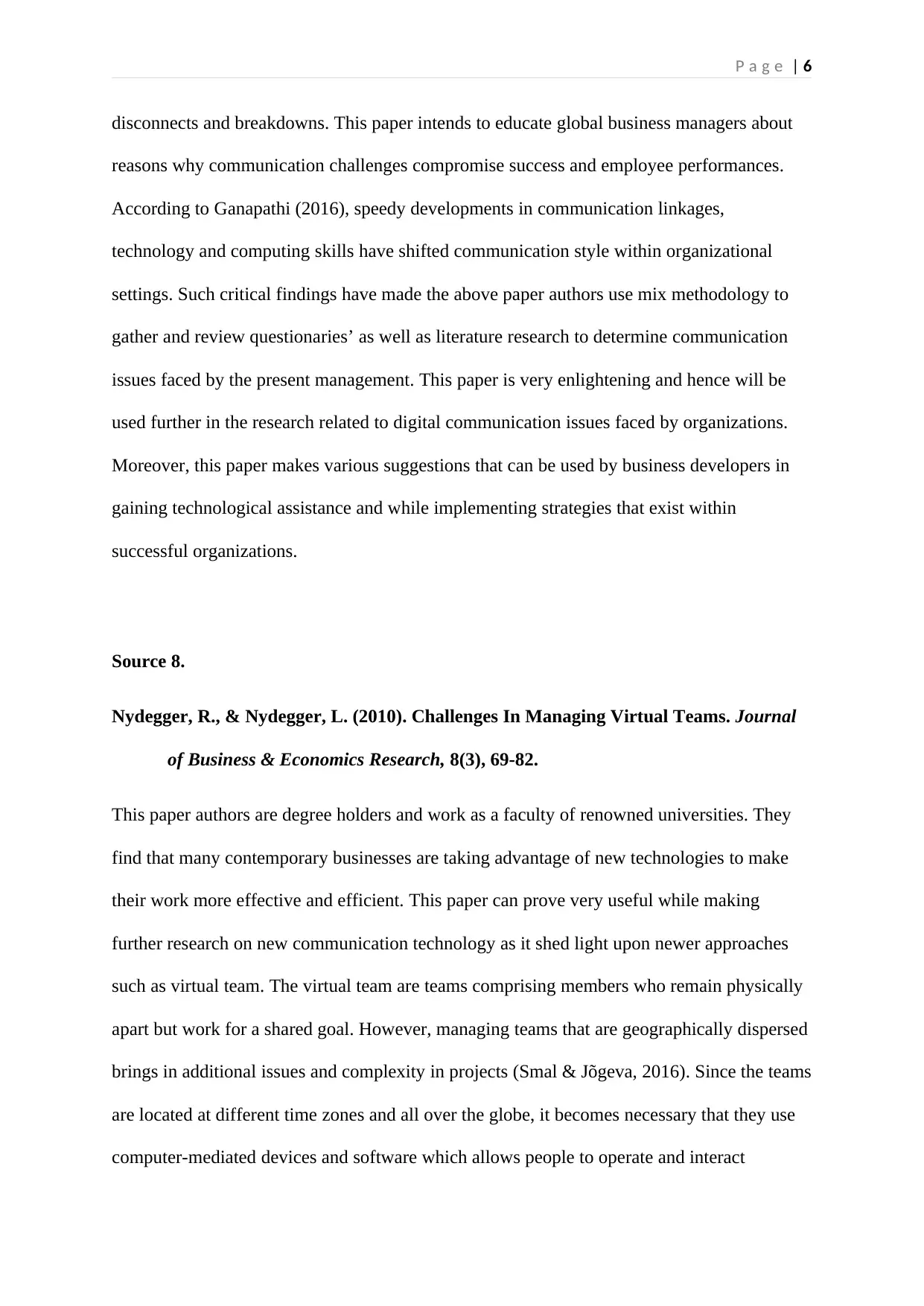
P a g e | 6
disconnects and breakdowns. This paper intends to educate global business managers about
reasons why communication challenges compromise success and employee performances.
According to Ganapathi (2016), speedy developments in communication linkages,
technology and computing skills have shifted communication style within organizational
settings. Such critical findings have made the above paper authors use mix methodology to
gather and review questionaries’ as well as literature research to determine communication
issues faced by the present management. This paper is very enlightening and hence will be
used further in the research related to digital communication issues faced by organizations.
Moreover, this paper makes various suggestions that can be used by business developers in
gaining technological assistance and while implementing strategies that exist within
successful organizations.
Source 8.
Nydegger, R., & Nydegger, L. (2010). Challenges In Managing Virtual Teams. Journal
of Business & Economics Research, 8(3), 69-82.
This paper authors are degree holders and work as a faculty of renowned universities. They
find that many contemporary businesses are taking advantage of new technologies to make
their work more effective and efficient. This paper can prove very useful while making
further research on new communication technology as it shed light upon newer approaches
such as virtual team. The virtual team are teams comprising members who remain physically
apart but work for a shared goal. However, managing teams that are geographically dispersed
brings in additional issues and complexity in projects (Smal & Jõgeva, 2016). Since the teams
are located at different time zones and all over the globe, it becomes necessary that they use
computer-mediated devices and software which allows people to operate and interact
disconnects and breakdowns. This paper intends to educate global business managers about
reasons why communication challenges compromise success and employee performances.
According to Ganapathi (2016), speedy developments in communication linkages,
technology and computing skills have shifted communication style within organizational
settings. Such critical findings have made the above paper authors use mix methodology to
gather and review questionaries’ as well as literature research to determine communication
issues faced by the present management. This paper is very enlightening and hence will be
used further in the research related to digital communication issues faced by organizations.
Moreover, this paper makes various suggestions that can be used by business developers in
gaining technological assistance and while implementing strategies that exist within
successful organizations.
Source 8.
Nydegger, R., & Nydegger, L. (2010). Challenges In Managing Virtual Teams. Journal
of Business & Economics Research, 8(3), 69-82.
This paper authors are degree holders and work as a faculty of renowned universities. They
find that many contemporary businesses are taking advantage of new technologies to make
their work more effective and efficient. This paper can prove very useful while making
further research on new communication technology as it shed light upon newer approaches
such as virtual team. The virtual team are teams comprising members who remain physically
apart but work for a shared goal. However, managing teams that are geographically dispersed
brings in additional issues and complexity in projects (Smal & Jõgeva, 2016). Since the teams
are located at different time zones and all over the globe, it becomes necessary that they use
computer-mediated devices and software which allows people to operate and interact
Paraphrase This Document
Need a fresh take? Get an instant paraphrase of this document with our AI Paraphraser
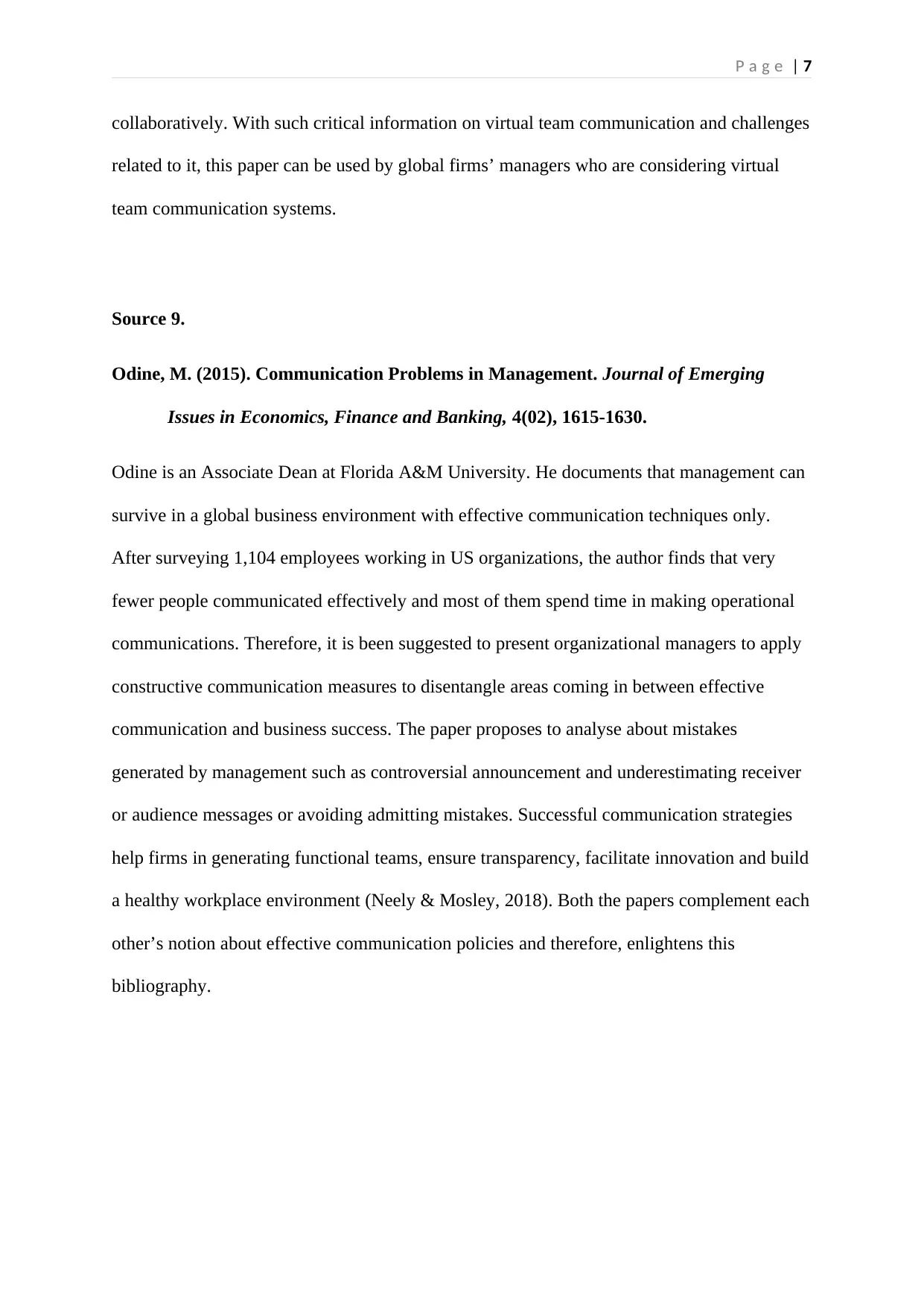
P a g e | 7
collaboratively. With such critical information on virtual team communication and challenges
related to it, this paper can be used by global firms’ managers who are considering virtual
team communication systems.
Source 9.
Odine, M. (2015). Communication Problems in Management. Journal of Emerging
Issues in Economics, Finance and Banking, 4(02), 1615-1630.
Odine is an Associate Dean at Florida A&M University. He documents that management can
survive in a global business environment with effective communication techniques only.
After surveying 1,104 employees working in US organizations, the author finds that very
fewer people communicated effectively and most of them spend time in making operational
communications. Therefore, it is been suggested to present organizational managers to apply
constructive communication measures to disentangle areas coming in between effective
communication and business success. The paper proposes to analyse about mistakes
generated by management such as controversial announcement and underestimating receiver
or audience messages or avoiding admitting mistakes. Successful communication strategies
help firms in generating functional teams, ensure transparency, facilitate innovation and build
a healthy workplace environment (Neely & Mosley, 2018). Both the papers complement each
other’s notion about effective communication policies and therefore, enlightens this
bibliography.
collaboratively. With such critical information on virtual team communication and challenges
related to it, this paper can be used by global firms’ managers who are considering virtual
team communication systems.
Source 9.
Odine, M. (2015). Communication Problems in Management. Journal of Emerging
Issues in Economics, Finance and Banking, 4(02), 1615-1630.
Odine is an Associate Dean at Florida A&M University. He documents that management can
survive in a global business environment with effective communication techniques only.
After surveying 1,104 employees working in US organizations, the author finds that very
fewer people communicated effectively and most of them spend time in making operational
communications. Therefore, it is been suggested to present organizational managers to apply
constructive communication measures to disentangle areas coming in between effective
communication and business success. The paper proposes to analyse about mistakes
generated by management such as controversial announcement and underestimating receiver
or audience messages or avoiding admitting mistakes. Successful communication strategies
help firms in generating functional teams, ensure transparency, facilitate innovation and build
a healthy workplace environment (Neely & Mosley, 2018). Both the papers complement each
other’s notion about effective communication policies and therefore, enlightens this
bibliography.
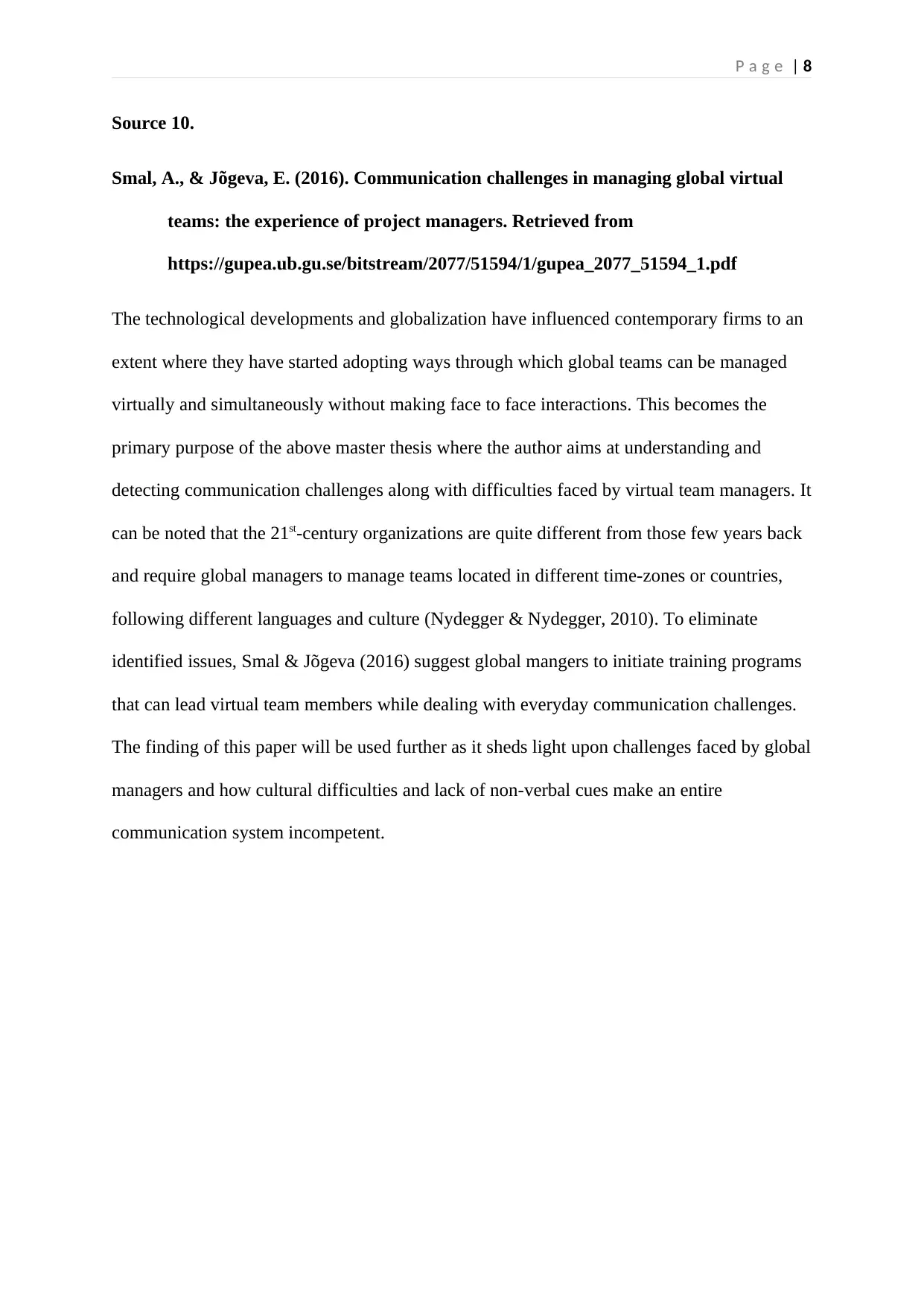
P a g e | 8
Source 10.
Smal, A., & Jõgeva, E. (2016). Communication challenges in managing global virtual
teams: the experience of project managers. Retrieved from
https://gupea.ub.gu.se/bitstream/2077/51594/1/gupea_2077_51594_1.pdf
The technological developments and globalization have influenced contemporary firms to an
extent where they have started adopting ways through which global teams can be managed
virtually and simultaneously without making face to face interactions. This becomes the
primary purpose of the above master thesis where the author aims at understanding and
detecting communication challenges along with difficulties faced by virtual team managers. It
can be noted that the 21st-century organizations are quite different from those few years back
and require global managers to manage teams located in different time-zones or countries,
following different languages and culture (Nydegger & Nydegger, 2010). To eliminate
identified issues, Smal & Jõgeva (2016) suggest global mangers to initiate training programs
that can lead virtual team members while dealing with everyday communication challenges.
The finding of this paper will be used further as it sheds light upon challenges faced by global
managers and how cultural difficulties and lack of non-verbal cues make an entire
communication system incompetent.
Source 10.
Smal, A., & Jõgeva, E. (2016). Communication challenges in managing global virtual
teams: the experience of project managers. Retrieved from
https://gupea.ub.gu.se/bitstream/2077/51594/1/gupea_2077_51594_1.pdf
The technological developments and globalization have influenced contemporary firms to an
extent where they have started adopting ways through which global teams can be managed
virtually and simultaneously without making face to face interactions. This becomes the
primary purpose of the above master thesis where the author aims at understanding and
detecting communication challenges along with difficulties faced by virtual team managers. It
can be noted that the 21st-century organizations are quite different from those few years back
and require global managers to manage teams located in different time-zones or countries,
following different languages and culture (Nydegger & Nydegger, 2010). To eliminate
identified issues, Smal & Jõgeva (2016) suggest global mangers to initiate training programs
that can lead virtual team members while dealing with everyday communication challenges.
The finding of this paper will be used further as it sheds light upon challenges faced by global
managers and how cultural difficulties and lack of non-verbal cues make an entire
communication system incompetent.
⊘ This is a preview!⊘
Do you want full access?
Subscribe today to unlock all pages.

Trusted by 1+ million students worldwide
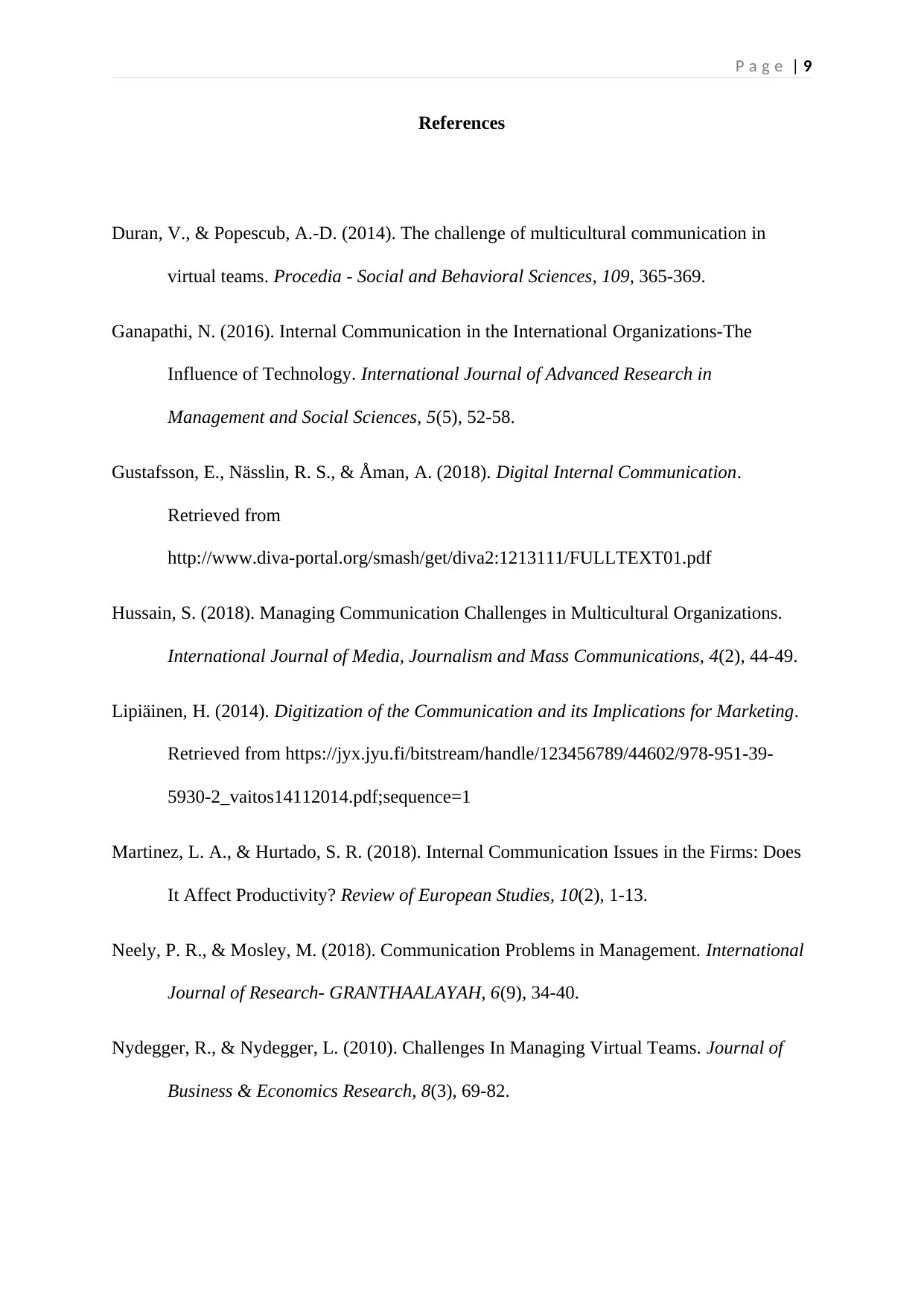
P a g e | 9
References
Duran, V., & Popescub, A.-D. (2014). The challenge of multicultural communication in
virtual teams. Procedia - Social and Behavioral Sciences, 109, 365-369.
Ganapathi, N. (2016). Internal Communication in the International Organizations-The
Influence of Technology. International Journal of Advanced Research in
Management and Social Sciences, 5(5), 52-58.
Gustafsson, E., Nässlin, R. S., & Åman, A. (2018). Digital Internal Communication.
Retrieved from
http://www.diva-portal.org/smash/get/diva2:1213111/FULLTEXT01.pdf
Hussain, S. (2018). Managing Communication Challenges in Multicultural Organizations.
International Journal of Media, Journalism and Mass Communications, 4(2), 44-49.
Lipiäinen, H. (2014). Digitization of the Communication and its Implications for Marketing.
Retrieved from https://jyx.jyu.fi/bitstream/handle/123456789/44602/978-951-39-
5930-2_vaitos14112014.pdf;sequence=1
Martinez, L. A., & Hurtado, S. R. (2018). Internal Communication Issues in the Firms: Does
It Affect Productivity? Review of European Studies, 10(2), 1-13.
Neely, P. R., & Mosley, M. (2018). Communication Problems in Management. International
Journal of Research- GRANTHAALAYAH, 6(9), 34-40.
Nydegger, R., & Nydegger, L. (2010). Challenges In Managing Virtual Teams. Journal of
Business & Economics Research, 8(3), 69-82.
References
Duran, V., & Popescub, A.-D. (2014). The challenge of multicultural communication in
virtual teams. Procedia - Social and Behavioral Sciences, 109, 365-369.
Ganapathi, N. (2016). Internal Communication in the International Organizations-The
Influence of Technology. International Journal of Advanced Research in
Management and Social Sciences, 5(5), 52-58.
Gustafsson, E., Nässlin, R. S., & Åman, A. (2018). Digital Internal Communication.
Retrieved from
http://www.diva-portal.org/smash/get/diva2:1213111/FULLTEXT01.pdf
Hussain, S. (2018). Managing Communication Challenges in Multicultural Organizations.
International Journal of Media, Journalism and Mass Communications, 4(2), 44-49.
Lipiäinen, H. (2014). Digitization of the Communication and its Implications for Marketing.
Retrieved from https://jyx.jyu.fi/bitstream/handle/123456789/44602/978-951-39-
5930-2_vaitos14112014.pdf;sequence=1
Martinez, L. A., & Hurtado, S. R. (2018). Internal Communication Issues in the Firms: Does
It Affect Productivity? Review of European Studies, 10(2), 1-13.
Neely, P. R., & Mosley, M. (2018). Communication Problems in Management. International
Journal of Research- GRANTHAALAYAH, 6(9), 34-40.
Nydegger, R., & Nydegger, L. (2010). Challenges In Managing Virtual Teams. Journal of
Business & Economics Research, 8(3), 69-82.
Paraphrase This Document
Need a fresh take? Get an instant paraphrase of this document with our AI Paraphraser
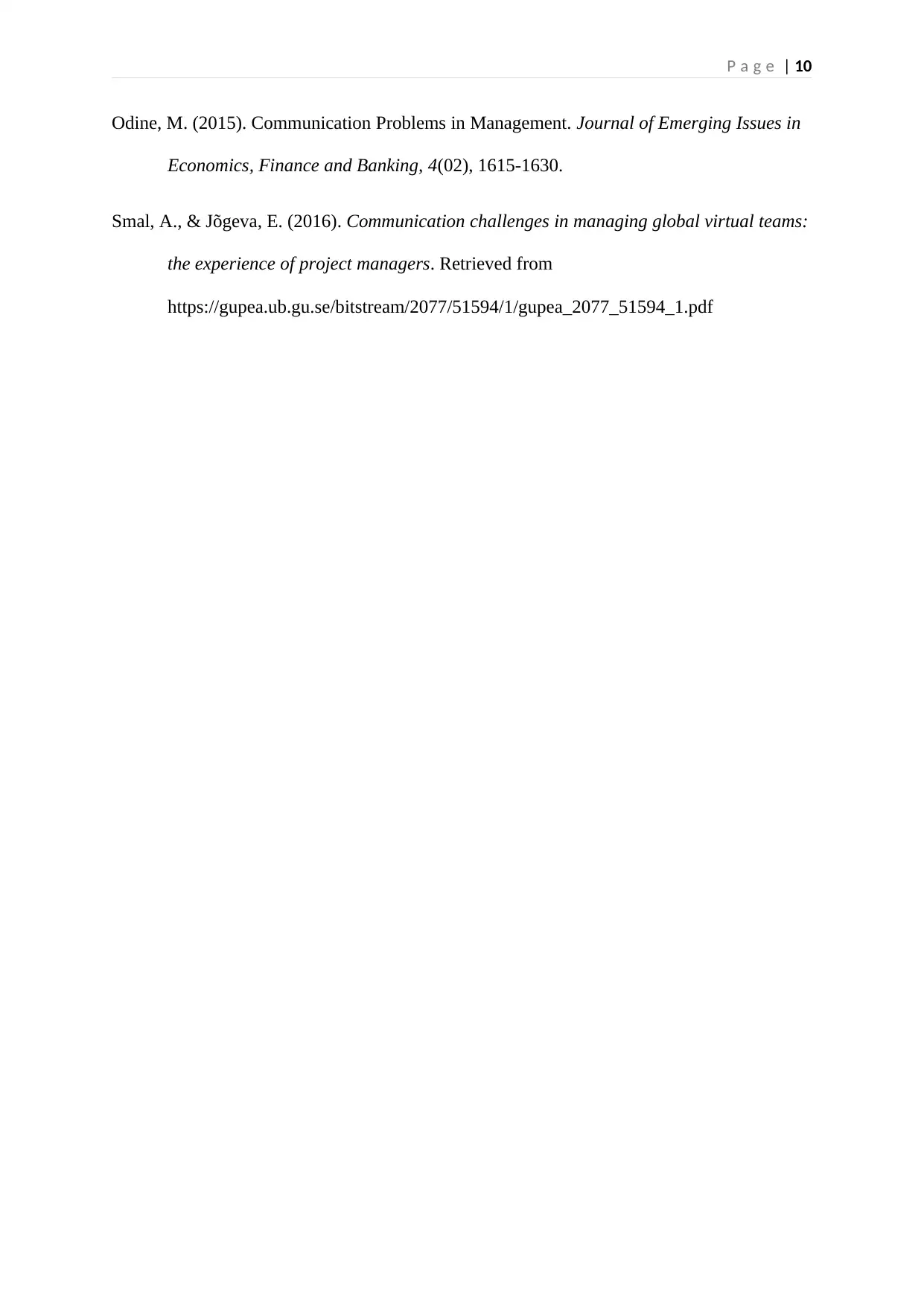
P a g e | 10
Odine, M. (2015). Communication Problems in Management. Journal of Emerging Issues in
Economics, Finance and Banking, 4(02), 1615-1630.
Smal, A., & Jõgeva, E. (2016). Communication challenges in managing global virtual teams:
the experience of project managers. Retrieved from
https://gupea.ub.gu.se/bitstream/2077/51594/1/gupea_2077_51594_1.pdf
Odine, M. (2015). Communication Problems in Management. Journal of Emerging Issues in
Economics, Finance and Banking, 4(02), 1615-1630.
Smal, A., & Jõgeva, E. (2016). Communication challenges in managing global virtual teams:
the experience of project managers. Retrieved from
https://gupea.ub.gu.se/bitstream/2077/51594/1/gupea_2077_51594_1.pdf
1 out of 11
Related Documents
Your All-in-One AI-Powered Toolkit for Academic Success.
+13062052269
info@desklib.com
Available 24*7 on WhatsApp / Email
![[object Object]](/_next/static/media/star-bottom.7253800d.svg)
Unlock your academic potential
Copyright © 2020–2025 A2Z Services. All Rights Reserved. Developed and managed by ZUCOL.





